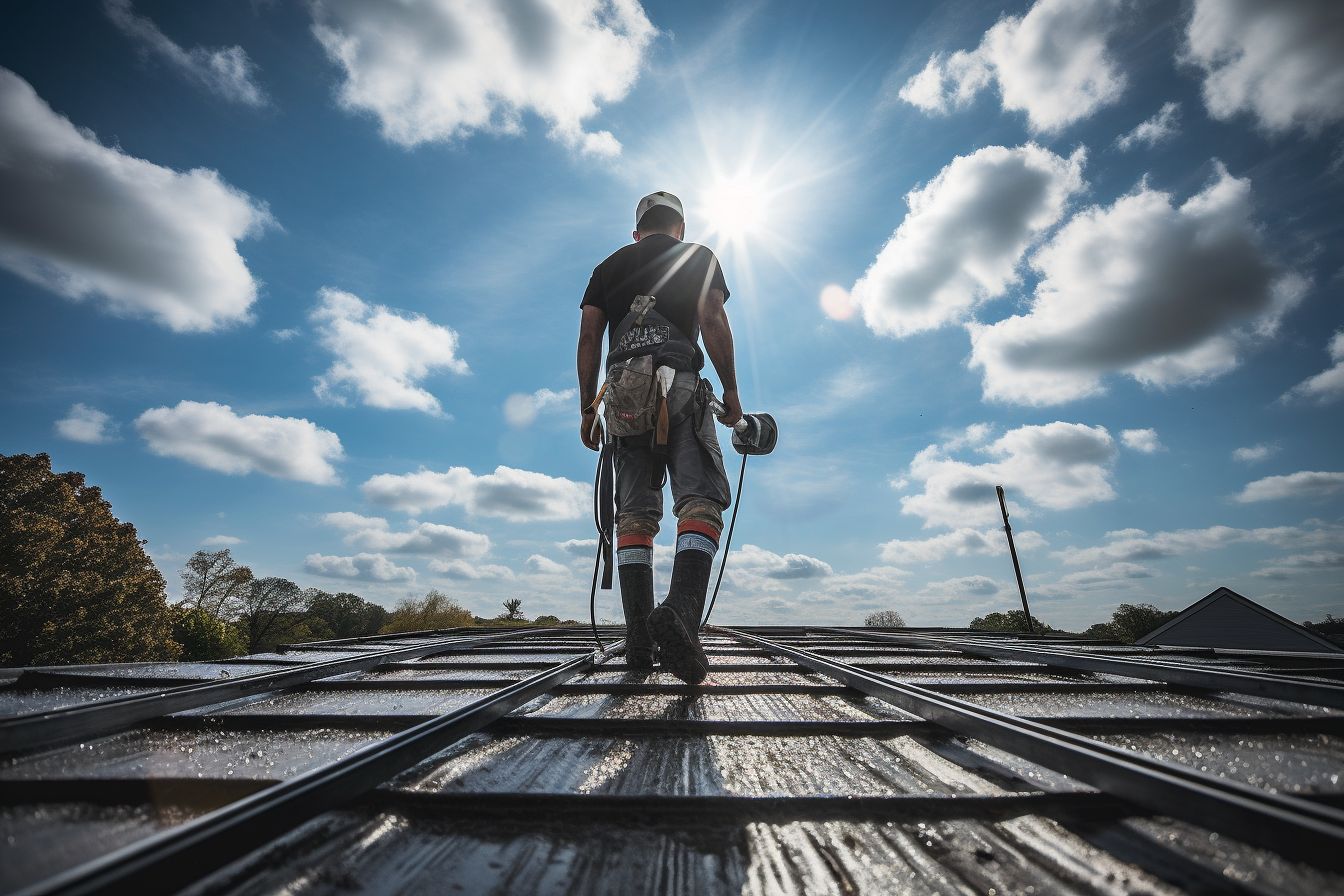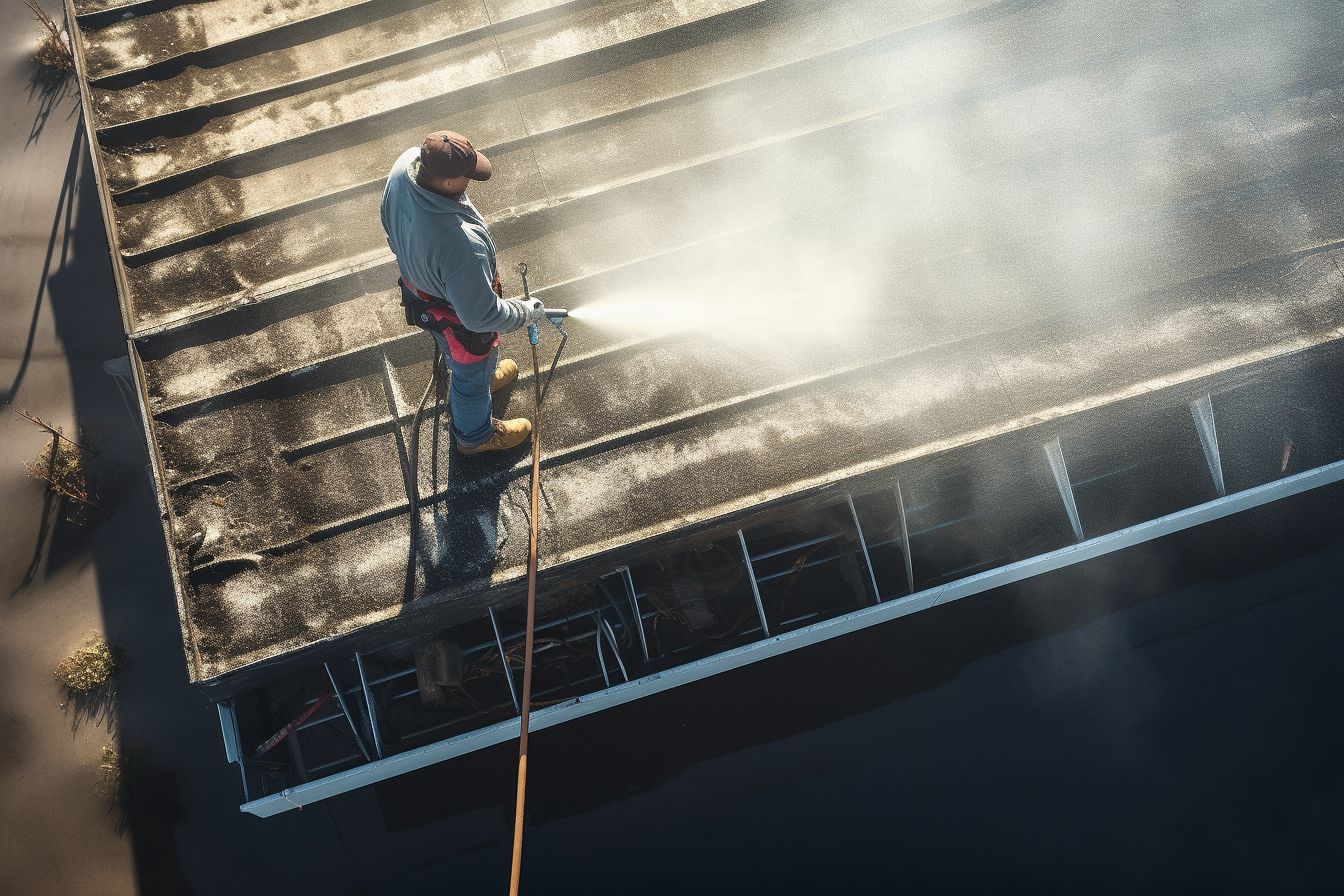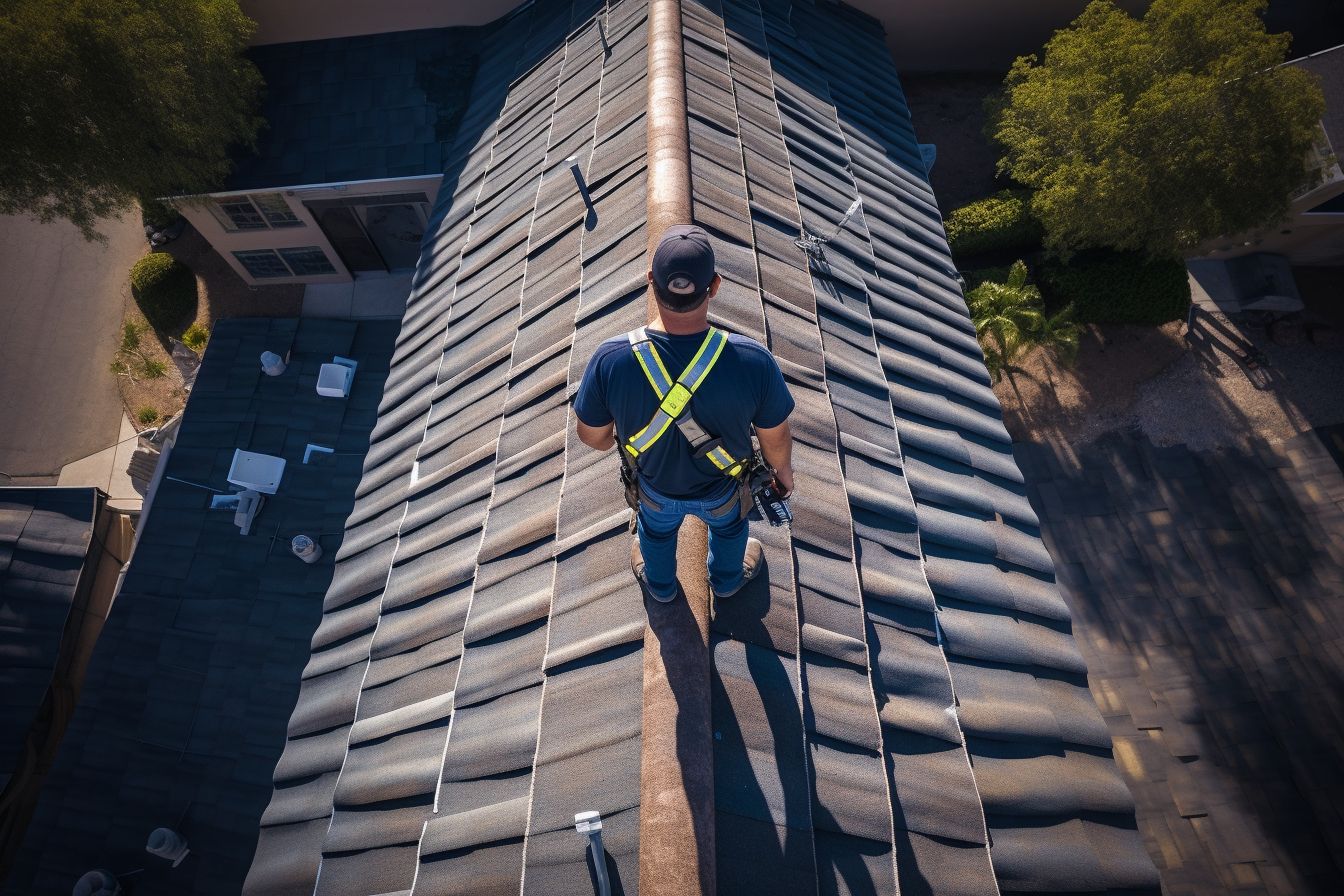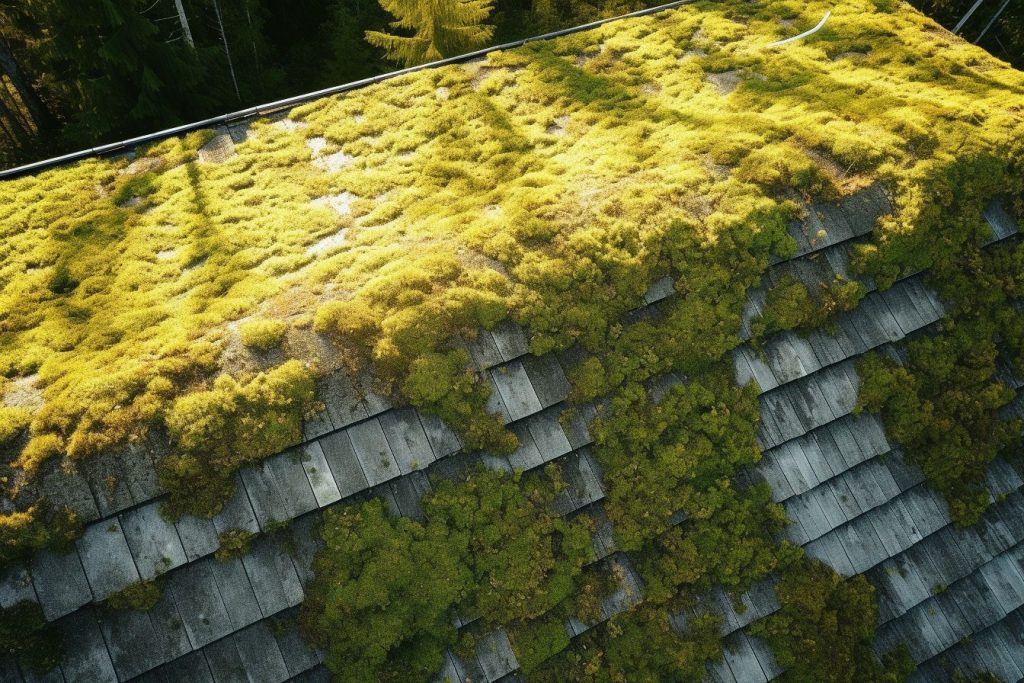Has the unsightly look of moss, algae or bird droppings on your roof caught your attention? Keeping your roof clean improves its appearance and prevents decay and extensive repairs.
Our blog post provides handy tips for cleaning your roof safely, efficiently, and without causing damage. Get ready to boost the lifespan of your shingles – let’s get started!
Key Takeaways
- Use a sprayer attached to a garden hose for gentle and effective roof cleaning.
- Avoid using pressure washers, as they can damage roofing materials.
- Regularly remove fallen leaves and debris to prevent moss and algae growth.
- Clean your gutters regularly to prevent water backup and potential roof damage.
Dos and Don’ts for Cleaning Your Roof

Do use a sprayer attached to a garden hose for gentle and effective cleaning.
Do use a sprayer attached to a garden hose
Using a sprayer attached to your garden hose provides an effective way to clean your roof. This method helps you maintain appropriate water pressure, preventing potential damage to roofing materials and mitigating the risk of leaks.
As you prepare your cleaning solution, dilute chlorine bleach adequately before applying it on the roof for moss removal, fungi prevention, and mildew treatment. Exercise caution during application, as chlorine can harm plants around your home.
The advantage of using a sprayer nozzle is that it simplifies the process by ensuring even coverage of the cleaning solution over large areas quickly and efficiently.
Don’t use a pressure washer.
Pressure washers may seem like a quick solution for cleaning your roof, but they pose significant risks. The high-pressure systems can easily damage roofing materials, weakening them significantly.
Gentle roof cleaning is always the best approach to maintaining your roof.
Beyond just harming the structural integrity of the shingles, pressure washers are known culprits in causing leaks and other types of extensive damage to roofs. Roofing safety precautions necessitate opting for nonpressure roof cleaning methods instead.
This safeguard helps preserve your roofing material over time and prevents unnecessary costs with repairs or replacements related to water damage.
Do remove fallen leaves and debris
Clearing your roof of fallen leaves and debris is crucial to roof maintenance. These unwanted materials can trap moisture, promoting the growth of moss, algae, and lichen that may damage roofing materials over time.
Leaves left unattended also create potential hazards as they can block gutters, causing water to overflow in unexpected areas or freeze into damaging ice dams in winter. Moreover, continual cleanup keeps the overall appearance of your house clean and appealing.
Consider using tools like long-handle rakes for effective removal or sweep them onto a tarp for an efficient cleanup without risking damage to your shingles by excessive foot traffic on the roof.
Overhanging branches should be trimmed regularly to reduce leaf accumulation and prevent potential storm damage from broken limbs. Regular debris removal helps maintain the integrity of your roof and aids in its stain prevention and hazard management endeavours.
Don’t neglect regular gutter cleaning.
Regular gutter cleaning is essential for maintaining the health and integrity of your roof. Neglecting this task can lead to clogged gutters, resulting in water backup and potential damage to your roof, walls, foundation, and other home areas.
Clogs in the gutters can also create an ideal breeding ground for pests and insects. To prevent these problems, clean your gutters frequently based on the amount of debris and environmental factors.
By staying on top of gutter maintenance, you can ensure proper water drainage, prevent structural damage, control moisture levels, and protect your home from potential disasters.
Steps to Clean Your Roof Properly
Start at the top and work your way down, applying a roof cleaning solution evenly and rinsing the roof thoroughly. Don’t forget to scrub stubborn algae if necessary. Read on to learn more about properly cleaning your roof.
Start at the top and work your way down.
To clean your roof properly, it’s essential to start at the top and work your way down. This ensures that debris or dirt is washed away without causing further damage. By starting at the highest point of your roof, you can easily rinse off any loose leaves or twigs before moving on to lower sections.
Working from top to bottom also allows any cleaning solution to run down gradually, effectively removing algae and other stubborn stains. By following this methodical approach, you’ll ensure a thorough and efficient cleaning process for your roof, helping to maintain its longevity and prevent future damage.
Remember: Start at the top and work your way down when cleaning your roof – this is key in maintaining its cleanliness and preventing potential issues caused by dirt buildup or debris accumulation.
Apply a roof-cleaning solution evenly.
Applying a roof cleaning solution evenly is essential in properly cleaning your roof. This chemical application helps to kill mould, remove contaminants, and treat asphalt shingles, ensuring a thorough cleaning.
When applying the cleaning solution, spray every shingle to eliminate any buildup effectively. It’s important to avoid using a pressure washer for this task as it can cause damage to the shingles.
Instead, opt for a sprayer attached to a garden hose for precise and controlled application. Applying the roof cleaning solution evenly ensures that all areas are treated and ready for thorough rinsing and scrubbing if necessary.
Rinse the roof thoroughly.
After applying a cleaning solution to your roof, it is crucial to rinse the roof thoroughly with clean water. This step is essential in removing any residue or dirt left behind after using bleach or a cleaning solution.
Rinse not only the surface of the roof but also any nearby plants and shrubbery to ensure all traces of the cleaning product are gone. By rinsing thoroughly, you can leave your roof looking clean and free from debris, ready to withstand the elements.
Scrub stubborn algae if necessary.
If you notice stubborn algae growth on your roof, it’s essential to address it promptly. Mix a 50:50 solution of liquid chlorine bleach and water to scrub away the algae. Apply this mixture to the affected areas using a scrubbing brush, gently scrubbing until the algae is removed.
Rinse thoroughly with water afterwards to ensure all traces of algae and bleach are gone. Remember, using gentle pressure and avoiding abrasive tools will help protect your roof from damage while effectively removing stubborn algae.
Expert Tips on Cleaning Your Roof

To ensure that your roof is properly cleaned, following expert tips and advice is essential. Start by consulting the manufacturer for specific instructions on cleaning your type of roof.
They can provide valuable insight into the best methods and products to use. Additionally, consider hiring a professional for complex cleaning tasks or if you’re unsure about tackling the job yourself.
By taking these expert tips into account, you can maintain a clean and well-maintained roof that will last longer and prevent potential issues in the future.
Tips for Maintaining a Clean Roof

Trim protruding branches, regularly clean off debris, install zinc or copper-coated sheet metal, and consider hiring a professional for complex cleaning tasks. Discover these crucial tips to keep your roof in top shape!
Trim protruding branches
Trimming protruding branches is an essential step in maintaining a clean roof and preventing damage. Overhanging branches can accumulate debris on the roof, which can cause moisture buildup and potential damage.
It is recommended to consult with an arborist or tree care professional to trim overhanging branches that are close to the roof safely. By regularly pruning these branches, you can protect your roof from falling debris and ensure it remains in good condition for years.
Regularly clean off debris.
Regularly cleaning off debris from your roof is crucial for maintaining a clean and healthy roof. Accumulated debris, such as fallen leaves and branches, can lead to decay and extensive repairs.
If left unattended, this could even result in the need for a complete roof replacement. By cleaning off the debris regularly, you can prevent these issues and extend the life of your roof.
Not only that, but it also helps to improve the overall appearance of your home’s exterior. So schedule annual cleanings to clear away debris and keep your roof in top shape.
Install zinc or copper-coated sheet metal.
Installing zinc or copper-coated sheet metal is a great way to maintain a clean roof. These metals are effective in preventing the growth of moss and other plant materials on your roof.
Zinc and copper roofing strips can be easily installed along the edges of your roof, creating a protective barrier that inhibits the growth of unwanted organisms. It’s important to note that when installing these strips, it’s best to avoid non-galvanized steel as it can cause staining on zinc surfaces.
By investing in this simple solution, you’ll not only protect your roof but also extend its lifespan.
By installing zinc or copper-coated sheet metal, you’re taking an essential step towards maintaining the cleanliness and durability of your roof. Using these metals helps prevent moss growth, which can lead to damage over time.
Consider hiring a professional for complex cleaning tasks.
Hiring a professional is highly recommended for complex cleaning tasks related to roof maintenance. This ensures that the job is done safely and effectively. When considering hiring a professional, comparing prices by getting written quotes from different companies is important.
Additionally, researching the credibility and reliability of the company is crucial. It’s also essential to check if the professional has insurance and liability coverage, especially for dangerous tasks like roof cleaning.
By hiring a professional, you can know that your roof surfaces will be handled with care and any existing damages will not be overlooked.
Conclusion

Clean your roof regularly to prevent decay and extensive repairs. Use a sprayer attached to a garden hose instead of a pressure washer to avoid damaging the shingles. Remove fallen leaves, debris, and algae promptly for optimal roof maintenance.
Consider hiring professionals for complex cleaning tasks and consult your manufacturer for specific instructions. With these tips, you can ensure your roof stays clean and in good condition for years.
FAQs
1. Can I clean my roof by myself?
You can clean your roof if you follow proper safety precautions and use the right tools and cleaning solutions.
2. What tools do I need for cleaning my roof?
You will need a sturdy ladder, a broom or brush with soft bristles, a garden hose with an adjustable nozzle, and a mild detergent or roof cleaner.
3. How often should I clean my roof?
It is recommended to clean your roof at least once a year to remove debris, moss, algae, and other buildup that can damage the shingles or tiles.
4. How should I safely move on the roof while cleaning it?
When moving on the roof while cleaning it, always wear non-slip shoes and step on the sturdy parts of the structure, like trusses or support beams. Avoid stepping directly on shingles or tiles to prevent damage.
5. Can pressure washing be used for cleaning roofs?
Pressure washing is not recommended for most roofs as it can cause damage to shingles or tiles. Using gentle manual methods such as brushing and rinsing with water is best.

